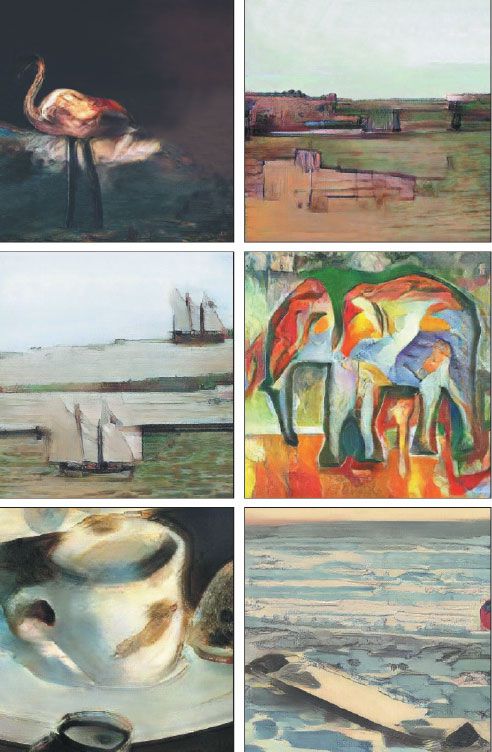


Six paintings by Xiaoice, which are displayed at an exhibition in Beijing on July 13. [Photos provided to China Daily]
Qiu Zhijie, an artist and professor at China's Central Academy of Fine Arts, said the answer depends on how originality in art is defined when machines are involved in creation.
"When nobody can tell the difference between paintings generated by AI and those of humans, then we can regard AI's work as original," Qiu said.
Apparently, Xiaoice has already passed the test. In May, works produced by the drawing bot under the name Xiao Yubing were submitted to the exhibition of postgraduates' work at China's Central Academy of Fine Arts. When Xiao Yubing's paintings were presented beside those of humans, nobody realized they were generated by AI.
"Art is quite different from industrial products. Audience feedback and personal feelings matter a lot. As long as people feel connected to or inspired by a painting, then we can call it a work of art," said Xu from Microsoft.
He recalled that one of his friends once typed the words: the office is very cold today, as an inspiration for Xiaoice, which then painted a rabbit in snow. The rabbit is white, except for its heart which is faint red. His friend felt touched by the red, which in his eyes signifies warmth in freezing cold.
According to Qiu who has been working closely with Microsoft studying AI creation, Xiaoice has made strides in the past months and now has a stable level of drawing quality.
"The first time I saw her paintings (in January), I only picked three to four from her 20 pictures as impressive. But in May, the number went up to 12 out of 20. Now I could pick as many as eight out of 10 pictures as fantastic," Qiu said.
At the ongoing exhibition, Xiaoice was set into six characters of women artists, representing six painting styles. Fast-learning capabilities allow the drawing bot to quickly master the subtle differences of how to approach the world from six diverging perspectives. Xiaoice could even tell how each painting was affected by each artist's style, Microsoft said.
Based on Xiaoice's impressive drawing capabilities, Microsoft is also exploring how AI could revolutionize the design industry. Xiaoice is now creating fabric designs for international fashion and garment producers, using new AI capabilities to create patterns based on words, themes and colors. These latest works have been produced in partnership with the China Textile Information Center and the China Textiles Development Center.
"It is exciting to know that Xiaoice can develop immaculate designs for the production of fabrics or ready-to-wear collections," said CTDC President Li Binhong.
"In an industry where trends can rapidly evolve on a day-to-day basis, AI will help us to stay ahead of the competition and deliver highly creative collections in record time. It definitely tackles the urgent transformation requirement of the fashion industry," Li added.
Scarves designed by Xiaoice and clothing brand Selected are now available for sale through the latter's 350 outlets in China. More cooperation on design will be unveiled soon, said Xu from Microsoft.
In his eyes, AI's deep involvement in art will also lower the barrier for more people to appreciate fine art, and Xiaoice will become more versatile and be a good companion for people.
"One day, when Xiaoice is given a photo, she will feel inspired and write a song and compose lyrics. After hearing the song, she will feel the need to draw a picture. Seeing the picture, she will be inspired to write a poem. Xiaoice could be on a perpetual creation cycle and better understand humans," Xu said.
 |
 Fire brigade in Shanghai holds group wedding
Fire brigade in Shanghai holds group wedding Tourists enjoy ice sculptures in Datan Town, north China
Tourists enjoy ice sculptures in Datan Town, north China Sunset scenery of Dayan Pagoda in Xi'an
Sunset scenery of Dayan Pagoda in Xi'an Tourists have fun at scenic spot in Nanlong Town, NW China
Tourists have fun at scenic spot in Nanlong Town, NW China Harbin attracts tourists by making best use of ice in winter
Harbin attracts tourists by making best use of ice in winter In pics: FIS Alpine Ski Women's World Cup Slalom
In pics: FIS Alpine Ski Women's World Cup Slalom Black-necked cranes rest at reservoir in Lhunzhub County, Lhasa
Black-necked cranes rest at reservoir in Lhunzhub County, Lhasa China's FAST telescope will be available to foreign scientists in April
China's FAST telescope will be available to foreign scientists in April "She power" plays indispensable role in poverty alleviation
"She power" plays indispensable role in poverty alleviation Top 10 world news events of People's Daily in 2020
Top 10 world news events of People's Daily in 2020 Top 10 China news events of People's Daily in 2020
Top 10 China news events of People's Daily in 2020 Top 10 media buzzwords of 2020
Top 10 media buzzwords of 2020 Year-ender:10 major tourism stories of 2020
Year-ender:10 major tourism stories of 2020 No interference in Venezuelan issues
No interference in Venezuelan issues
 Biz prepares for trade spat
Biz prepares for trade spat
 Broadcasting Continent
Broadcasting Continent Australia wins Chinese CEOs as US loses
Australia wins Chinese CEOs as US loses